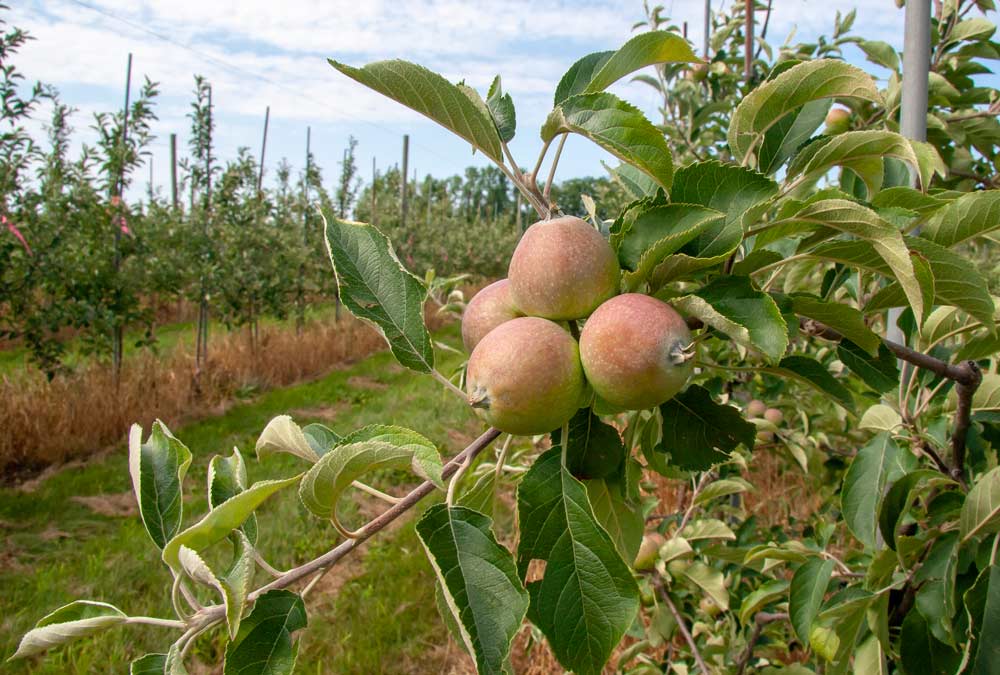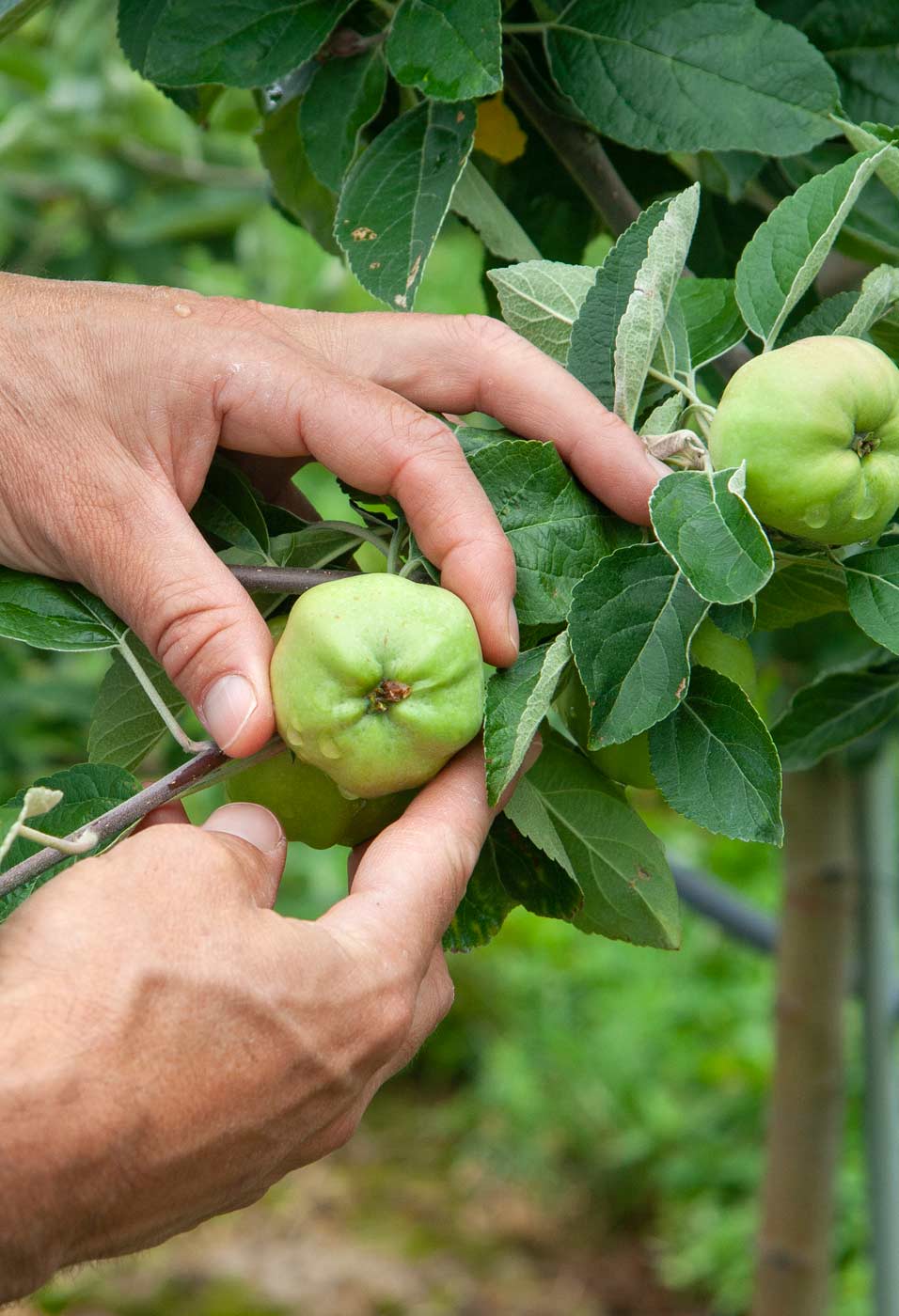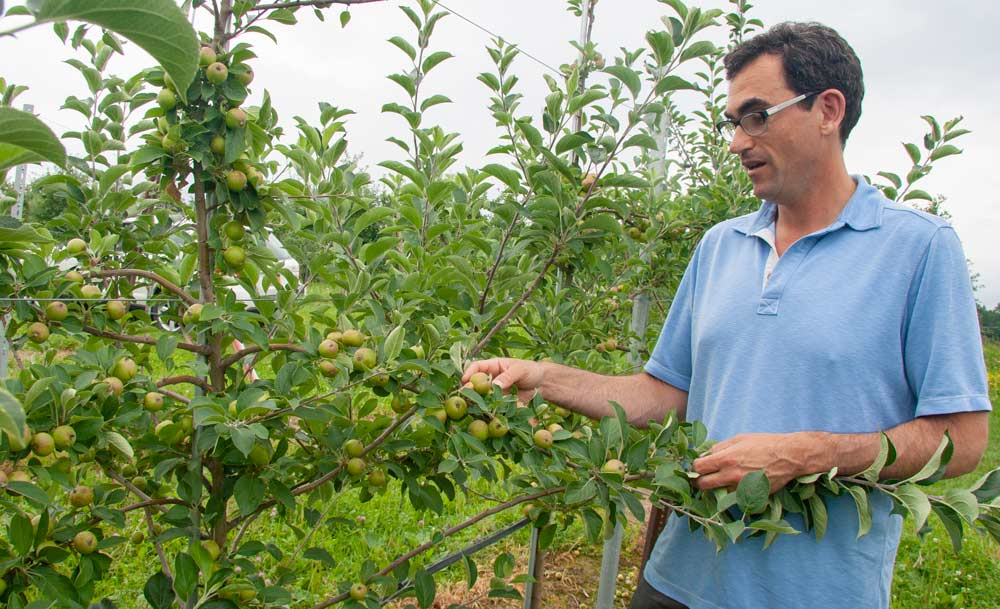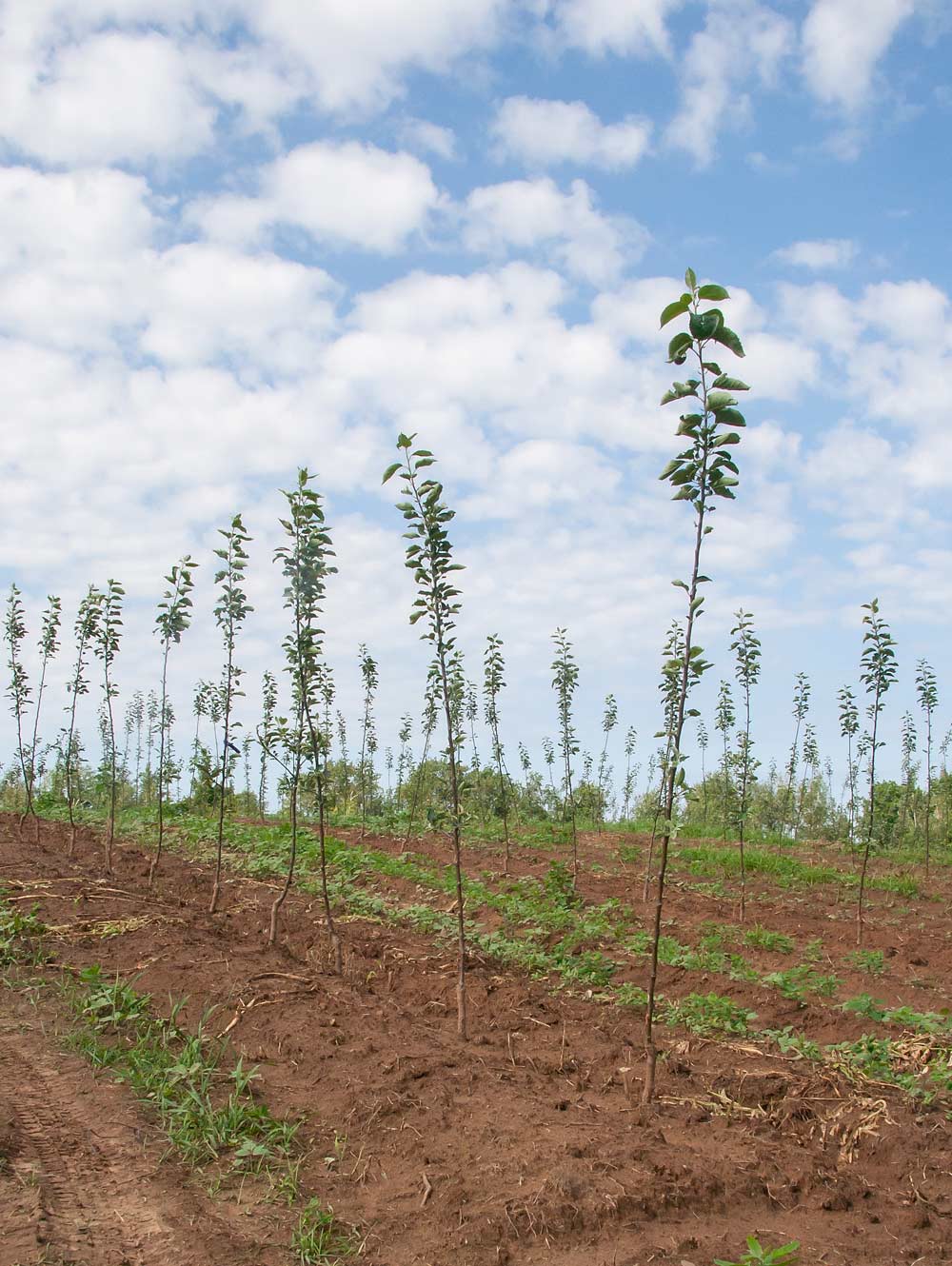
Bittersweet Chisel Jersey cider apples grow in a high density planting at LynOaken Farms in Western New York. Grower Chris Oakes planted 5 acres with five varieties of bittersweet cider apples and Chisel Jersey is one of his favorites because it tends less biennial than most other bittersweets. (Kate Prengaman/Good Fruit Grower)
There’s nothing new in Greg Peck’s variety trials. At least, not in the way you might expect.
Rather, he’s giving old apple varieties, prized for cider making, a new look to see which could be promising performers in a modern, high-density orchard.
“We’re reinventing the wheel from a century ago,” said Peck, a horticulture professor at Cornell University, of his growing research program into how best to grow cider apples in New York.
But while the flavors that make good hard cider haven’t changed much in 100 years, efficient horticultural practices have evolved.
Meanwhile, the American cider industry boom — nearing a $1.3 billion industry according to recent estimates — has been built on dessert apples, sweet and sometimes sharp fruit designed for eating fresh, rather than traditional bittersharp and bittersweet fruit grown for cider.
Craft cider-makers are increasingly interested in traditional varieties, if they can get them.
A report released earlier this year by Cornell Cooperative Extension’s Harvest New York program found supply chain challenges are limiting industry growth: Cider-makers have trouble sourcing or affording cider apples, but growers are concerned about investing in unfamiliar cultivars with increased disease risks and question the long-term stability of the cider market.

Pomologist Greg Peck shows off the characteristic lobes of a Calville Blanc apple that’s part of his cider apple experiments at the Cornell Orchards in Ithaca, New York. (Kate Prengaman/Good Fruit Grower)
High demand has created high prices, which have spurred more commercial growers to experiment with cider apples, but still mostly on a small scale.
There are only about 200 acres of specialty cider apples and dual-purpose heirloom apples in New York, according to the 43 growers who responded to the Harvest New York survey in 2017.
“To my knowledge, we haven’t seen wide scale plantings where people are pulling out culinary apples or processing apples and putting in cider varieties,” Peck said. “At $20,000 an acre for a new orchard, and you are counting on this new industry to be your primary buyer for this fruit, there’s a lot of risk involved.”
His research program aims to reduce those risks by identifying promising varieties that have the qualities cider-makers want, such as high tannins and high acidity but are cost-effective and reliable to grow.
“Thinking about what we need to scale this industry up, we need apples that are productive and disease resistant and amenable to the orchard systems our commercial apple growers understand,” Peck said.

Managing cropload can be challenging when it comes to cider varieties such as this Medaille d’Or, which produces many small apples and all those seeds suppress the development of next season’s fruiting buds, said Cornell University Pomologist Greg Peck. (Kate Prengaman/Good Fruit Grower)
To that end, he’s launched a variety of research projects since joining Cornell in 2015. One of his graduate students, Nathan Wojtyna, is looking at the genetics of over 180 apples, including traditional cider cultivars and Malus species at the U.S. Department of Agriculture’s apple germplasm collection in Geneva, to find the markers for traits important to cider production and horticulture.
Another student is working with New York apple growers who do have cider blocks to assess the costs of production. Figuring out what prices for cider apples will be needed to support the investment in new orchards for a 25-year lifespan, Peck said.
In terms of horticulture, Peck is looking at nine classic European bittersweets he planted in 2015: Binet Rouge; Brown Snout; Brown’s Apple; Chisel Jersey; Dabinett; Ellis Bitter, Harry Masters Jersey; Tremlett’s Bitter and Vilberie, along with the bittersharp Porter’s Perfection, which has both tart and bitter flavors that could create single variety cider.
This spring, he plans to plant another trial block with Spanish cider apples and further trials with English and French cider apples are in the works, once the trees clear the USDA-APHIS quarantine process.
He’s also got plantings of Golden Russet, an heirloom American sharp apple, Calville Blanc, a French sharp, and Medaille d’Or, a classic French bittersweet, for an experiment to see how nitrogen fertilization affects the levels of polyphenols and yeast-available nitrogen in the resulting juice, a key component for healthy fermentation.
Traditional cider apples come with a variety of negatives when it comes to production in today’s orchards, including disease susceptibility and biennial bearing.
Peck’s Medaille d’Or serves as an example — the third-leaf tree was covered in tiny fruit. They only reach racquetball size, but all those seeds produce gibberlins and auxins that inhibit development of next season’s fruiting buds.

Interest in heirloom apples is growing for fresh consumption as well as cider production, and this new planting will serve both, said Chris Oakes of LynOaken Farms. The block, seen here awaiting a trellis in the summer of 2017, includes Cox’s Orange Pippin, Ashmead’s Kernal, Golden Russet, and Northern Spy. (Kate Prengaman/Good Fruit Grower)
Peck partnered with grower Chris Oakes of LynOaken Farms in Medina, New York, to test out the optimum crop load on eight bittersweet varieties Oakes has planted in a high-density system.
They want to find the right balance to minimize biennial tendencies and improve juice qualities while still maximizing production.
“The challenge is that one year you’ll get a great crop, and the next year you won’t get any,” Oakes said. Some cultivars, such as bittersweet Chisel Jersey, are easier to manage because they are less biennial and a little more vigorous in the tall spindle system, he said.
“We manage them like fresh market apples, except with less pruning because we’re trying to go for high yields,” Oakes said. Eventually, he plans to mechanize the 5-acre block as much as possible with hedging and hopefully a mechanical harvest option in the future.
In the long run, Peck expects a handful of cider apples to prove themselves to be the mainstays of the new industry, varieties that commercial growers will feel comfortable investing in soon.
He predicts that there will also be a niche market for diverse heirloom varieties with unique characteristics for craft cider makers who want a signature flavor and unusual trees in their estate orchard and who are willing to trade off on things like biennial bearing and higher fire blight risks. •
—by Kate Prengaman
The original caption on the photo of the Calville Blanc apple incorrectly identified the apple’s type and has been updated. As listed in the article, Calville Blanc is an heirloom American sharp apple, not a bittersweet.






Somebody should amend the caption for the Calville Blanc photo- it’s a sharp, not a bittersweet.
Thanks Matt. We’ve corrected the caption.